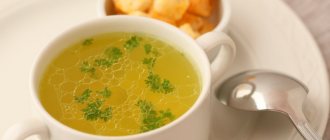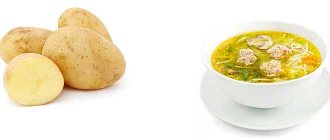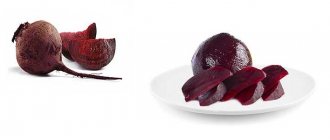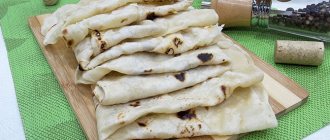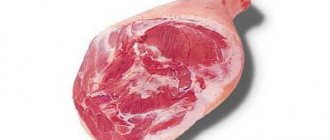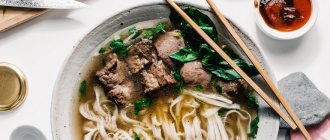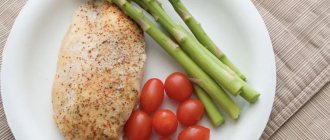Chicken broth calories
The nutritional value of chicken broth depends on the ingredients.
The nutritional value of chicken broth depends on the ingredients; yushka accounts for 20-100 kcal per 100 grams. Low calorie content is typical for empty decoction of bones and cartilage of broiler birds - 20-25 kcal.
The fattest and most harmful part of the chicken is the skin. Antibiotics and hormones on which the bird grew up are deposited in it.
BZHU content (per 100 g):
- proteins – 2-3 g;
- fats – 0.5-1.5 g;
- carbohydrates – 0.3-3.5 g.
The percentage ratio of BZHU is 34: 64: 3.
Factors affecting the calorie content of chicken broth
The nutritional value is primarily influenced by which parts of the broiler were first cooked. A traditional ancient recipe in Europe is considered to be yushka made from poultry cartilage and bones.
Now housewives add finely chopped herbs and vegetables, which increases the calorie content of the broth.
In order to understand how the fat content of a certain part of the bird affects the richness, it is enough to study the table of the value of the individual components of the carcass:
| Part | Calorie content of raw meat per 100 g, kcal | Calorie content of boiled meat per 100 g, kcal |
| Breast | 113 | 95 |
| Hip | 185 | 175 |
| Ham | 195 | 185 |
| Wings | 222 | 166 |
| Necks | 297 | 175 |
| Backs | 319 | 160 |
Be sure to read: How many calories are in soup: table of popular types and how to reduce their calorie content?
The nutritional value varies depending on the cooking time, the container in which it was cooked (whether the lid is open), and the recipe. If the first foam was removed, the water was drained or diluted, then the first will receive a minimum of nutritional value and calories.
The longer the broth boils, the lower the nutritional value will be.
Important! The main factor influencing oiliness is the presence of skin. If the chicken has been skinned and washed in advance, then the nutritional value of the broth is reduced by 30-50%.
Classic recipe
Chicken broth (the calorie content of the product depends on the parts of the chicken used to make it) is prepared from fresh chicken meat (or bones) and water.
Composition of ingredients
According to the classic recipe, the decoction includes:
- 1 kg chicken meat (or bones);
- 3.5 liters of water;
- small carrots and onions;
- 2-3 pcs. bay leaf;
- 1/2 tsp. salt.
You only need to use fresh chicken for the broth, preferably a freshly plucked laying hen, since a broiler contains more hormones and antibiotics. The carcass is cut and the neck, breast, thighs, wings (or bones with a small amount of meat) are used.
It is better to remove the skin, since it is in it that the drugs used for the active growth of the chicken accumulate. You can cook uncut chicken, but then the broth should be simmered for 1 hour longer. It is recommended to take at least 3 liters of water. The liquid should completely cover the meat lying in the pan, rising 3.5-4 cm above the chicken.
In addition to meat, onions, carrots and herbs are added to the broth. Vegetables can be used raw or sauteed, thereby making the broth more rich. In a metropolis, you can make broth from a special “soup set” consisting of cleaned parts of a broiler chicken. It is not recommended to use one breast.
Step-by-step cooking process
It is recommended to prepare the broth in a 4-liter saucepan.
Cooking process:
- The chicken needs to be washed under running water, cut into small pieces (or left whole), you can peel the skin, but not necessarily, and then put it in a 4-liter pan and fill it with 3 liters of water. The liquid should completely cover the meat and rise 3.5-4 cm above it. You can get tasty meat if you add salt to the broth at the beginning of cooking. To create a light and pleasant-tasting broth, spices should be added 10 minutes in advance. until the dish is ready.
- Place the pan with meat on the burner, turning it on to medium power.
- After approximately 20-30 minutes. Bubbles and white foam will form on the surface of the broth, appearing when the broth boils. The resulting foam must be carefully removed with a slotted spoon or a spoon with holes, and then turn down the heat, leaving the broth to cook for approximately another 70-80 minutes.
- Onions and carrots need to be peeled. Next, the carrots need to be cut into pieces, and the onion can be left whole.
- After 5 min. After boiling, add vegetables to the pan with the broth, then cover the container with a lid and leave the mixture to cook for at least another hour.
- After the specified time has passed, you need to carefully probe the meat with a fork. If the pulp easily separates from the bone, this means the broth is ready.
- In 15 min. Before removing from the stove, add bay leaf and black pepper to the broth.
- The finished broth should be removed from the stove and left to cool slightly (about 15 minutes). You need to remove vegetables and chicken from the pan.
- The cooled broth must be carefully passed through clean gauze (fine sieve), and then poured into glasses or soup plates.
Boiled chicken pulp is further used to create salads or soups.
What can I add?
If desired, add to the chicken broth:
- onion peel - it will give the broth a rich golden hue;
- homemade or industrially produced noodles;
- half a boiled egg;
- chopped dill or parsley;
- sauteed root vegetables;
- rice noodles;
- garlic;
- green algae.
The last two ingredients will give the broth an exotic taste and originality.
How to serve a dish
The broth is placed on the table in deep mugs or soup bowls. Before serving, be sure to check the broth for taste and, if necessary, add the necessary spices.
You can optionally put in a plate with broth:
- homemade noodles cooked separately. In this case, the pasta should be placed in a plate in advance, and then pour hot broth on top.
- 1⁄2 part boiled egg;
- chopped garlic, dill or parsley.
Children are recommended to offer toasted croutons or white bread croutons with the broth.
How to calculate the calorie content of broth with different ingredients
A simple way to calculate the nutritional value of the finished chicken broth is to multiply the nutritional value of the raw part of the carcass by a factor of 0.9.
To find out how many kilocalories are in a pure broth, subtract the calorie content of the boiled part from the calorie content of the raw part of the chicken, multiply the result by the mass of meat and divide by the volume of water.
If other ingredients were used, the formula will help calculate the nutritional value per 100 g: (kcal of raw meat + kcal of vegetables + ...) / (weight of meat (g) + weight of vegetables (g) + ... + volume of water (ml)).
Calculation of recipe calorie content per 1000 grams
The calculation of the calorie content of 1000 grams of the recipe is based on the summarized indicators of BZhUK (abbreviation: proteins-fats-carbohydrates-acids) of the ingredients from table (1) involved in the preparation. The data is taken from the database of the “products” section of the website and is brought into line with the final product yield (net).
In our example, proteins are involved - 57.49 grams, fats - 22.15 grams and carbohydrates - 2.73 grams contained in 1000 grams of the recipe. Next we perform the calculation:
Energy value of 1000 grams of recipe = 57.49 (proteins)*4 + 22.15 (fat)*9 + 2.73 (carbohydrates)*4 = 229.96 + 199.35 + 10.92 = 440.2 kcal
How to reduce the calorie content of broth?
For a dietary dish, carcasses with the lowest fat content and calorie content are selected.
For a dietary dish, carcasses with the lowest fat content and calorie content (breasts, thighs, wings) are selected. It is better to refrain from adding potatoes, crackers, and eggs.
When cooking, it is recommended to use a minimum of salt and seasonings: they delay the removal of water from the body and accumulate it in soft tissues.
There are unspoken rules that help reduce calories:
- Before cooking, the bird is skinned and excess fat is removed from the carcass;
- after boiling, the foam is removed, harmful substances and fats rise to the top;
- It is recommended to drain the first broth, then fill the chicken with clean water and cook until tender.
Ways to reduce calories
To make the broth low-fat and less high in calories, it is recommended to cook it from the sirloin of a carcass without skin. However, in this case it will turn out not only dietary, but also not very tasty, bland. To keep the calorie content within the normal range and still get a good rich taste, it is best to cook the broth from the thigh with the skin and the breast without the skin (fillet) at the same time.
You can also follow these rules to reduce calories:
- when the broth first boils, you should drain the first water, rinse the meat and refill with water, put on fire;
- after the next boil, the foam must be removed from the surface of the broth;
- to obtain a less fatty broth, you need to use twice as much water as meat;
- Before cooking, it is better to trim off excess fat;
- When using meat on the bone, there is no need to cook it for a long time, since in this case gelatin will begin to release, which negatively affects the dietary qualities of chicken broth.
On a note! The saturation and transparency of the broth is directly related to the cooking method, the parts of the carcass used, and the cooking time. For example, the calorie content of broth made from skinless breast will be the lowest. At the same time, the yushka will turn out more transparent and pale. And, conversely, the calorie content and density of chicken broth from thighs with skin or backs will be higher.
Regardless of the calorie content and the choice of parts of the carcass, the highest quality and tasty chicken broth is obtained from poultry raised on natural feed, without the addition of chemicals.
How to make broth really tasty?
Of course, the most delicious rich soup is made from different parts of the chicken. The meat is boiled with the bone, preferably with cartilage. The foam is removed, it adds bitterness.
If you are not cooking a separate dish, but a basis for further manipulations (preparing sauces, dressings, pastas), then cooks recommend adding cheese crusts. Place them in cold water and keep until ready.
Be sure to read: Weight loss soups that burn fat: recipes at home + photos
If there are vegetables in the soup, then add them according to the duration of cooking. The one that will require more cooking time goes first. For example, first add legumes, potatoes, mushrooms, and after 15-20 minutes add bell peppers, carrots, and onions. At the end - asparagus, celery, zucchini.
Important! To achieve a pleasant aroma, it is recommended to add dry herbs, bay leaves, and high-quality spices. You don't need a lot of salt, especially if cheese has already been added.
Menu for diet
Chicken broth (the calorie content of the product is considered to be quite low, which allows the broth to be used as the basis for mono-diets and fasting days) used in dietary nutrition can only be prepared from laying hen fillets that have been previously skinned.
It is not allowed to add any spices to the broth during the cooking process, except celery root.
In addition to losing excess weight, a chicken broth diet allows you to normalize digestion and cleanse the body of the accumulation of fecal stones and toxins.
Depending on the duration, fasting days, 3- and 7-day diets can be organized on chicken broth.
Fasting day
It consists of a one-day dietary restriction of only chicken broth and allows you to quickly cleanse the body of toxins and 1.5 kg of excess weight. This diet can be practiced by athletes who are “drying” the body.
Mono-diet.
Very strict, requires limiting the diet to only chicken broth, green tea and water for 3 days. Allows you to lose up to 5-7 kg, but is accompanied by a constant feeling of hunger.
Regular 7 days
Not a strict diet, consisting of a 7-day food restriction of chicken broth and an allowed list of foods, consisting of:
- chicken fillet;
- low-calorie vegetables;
- low-fat cottage cheese and cheese;
- bio-yogurt and bio-kefir;
- fruit;
- croup;
- bran
It is prohibited to consume during the diet:
- sweets and confectionery;
- fatty types of meat, fish and poultry;
- starchy root vegetables;
- berries;
- carbonated drinks.
Sample menu:
| Breakfast |
|
| Snack |
|
| Dinner |
|
| Snack |
|
| Dinner |
|
In 7-14 days of such nutrition, you can lose 5-7 kg of excess weight without harm to the body.
Real chicken broth, nicknamed “European penicillin,” is prepared from freshly killed, gutted and well-plucked chicken, with the addition of 2 carrots, 2 onions, celery, peppercorns and bay leaves.
The foam that appears on the surface of the broth when boiling is carefully removed, and then vegetables are added to the broth, leaving to cook for about 3 more hours.
After cooking, the cooked meat is removed from the broth, and then, in order to remove spices, the broth is filtered twice through a clean layer of dense material.
When properly prepared, the calorie content of the broth will be about 50-60 kcal, which allows it to become the main restorative product after a serious operation or illness.
It is known that during illness a person’s appetite is greatly reduced, allowing him to swallow no more than 3-6 tablespoons of chicken broth, which helps to quickly activate the immune system and restore the activity of the gastrointestinal tract.
Due to its low calorie content and excellent medicinal properties, the use of broth is especially recommended for obese people in order to quickly activate metabolic processes.
Chicken broth recipe for weight loss
Chicken broth recipe for weight loss
Nutritionists recommend drinking broth during strict diets and including it in the main diet: it fills the stomach and nourishes the body with the necessary microelements. The brain receives a signal about the filling of the digestive organ - the person feels full.
Another advantage of the prepared dish is its low calorie content; even a dish made from fatty parts of chicken with the addition of potatoes can be considered dietary. But a recipe for a tasty and light soup should not include anything other than meat, water, onions, and carrots.
To prepare you will need:
- breast 400-600 grams (with bones and cartilage, but skinned);
- 1.5-2 liters of water;
- whole medium-sized onion;
- medium carrot;
- 2 bay leaves;
- parsley, dill, pepper, salt - to taste.
Preparation:
- The breast is placed in a pan, filled with water and placed on the stove.
- After boiling, take the bird out, drain the water, rinse the pan, and fill it with clean water.
- The bird is again placed in cold water and cooked until done for an hour. To make the soup transparent, add a whole onion during the cooking process and throw it away at the end.
- The carrots are cut, placed in boiling water, and boiled for 15-20 minutes. At the same time, add spices, bay leaf, pepper, and salt.
- To rid the liquid of small pieces of chicken, peppercorns and grains of spices, you can pass the fish through cheesecloth, after removing the meat and carrots from it.
- Before serving, the dish is decorated with parsley or dill.
Be sure to read: Onion soup diet for weight loss for a week, 10 days
Benefits and harms
Chicken broth (calorie content of the product is given below in the article) is a unique nutritional product that helps quickly restore the body after undergoing strip surgery or a serious illness. The decoction is also useful for fractures, since the large amount of gelatin in its composition promotes the rapid fusion of bone and cartilage tissue.
Useful material:
| Vitamins |
|
| Minerals |
|
| Saturated fatty acids | 1,3 |
| Polyunsaturated fatty acids | 1,07 |
| Monosaturated acids | 1,8 |
Eating chicken broth helps:
- quickly restore the body and activate the immune system, which is especially important in the recovery period after operations and severe infections;
- remove mucus from the respiratory tract, easing the course of pneumonia, bronchitis or asthma;
- suppress hunger and reduce body weight;
- start metabolic processes;
- remove fecal stones and toxins from the intestines;
- improve peristalsis and, due to the enveloping effect, prevent exacerbation of peptic ulcer;
- fill the body with B vitamins, thiamine, niacin;
- compact bone tissue and quickly heal fractures and ruptures of cartilage tissue;
- speed up the digestion of heavy foods;
- tone the nervous system;
- cope with insomnia and increased irritability;
- Due to the large amount of collagen contained in gelatin, it starts cellular regeneration and prevents brittle nails and split hair.
Chicken broth itself is very healthy, and can only harm the body if low-quality raw materials are used for its preparation.
When cooking begins for 20-35, various hubbub and antibiotics involved in raising poultry enter the water, so after the first boil, nutritionists recommend draining the first broth, pouring a fresh portion of water over the bones and pulp. Rich broth is contraindicated for people suffering from:
- diseases of the liver and gall bladder;
- increased acidity;
- pancreatitis.
For people suffering from chronic gastrointestinal pathologies, chicken broth cooked in 2nd water or strained broth is suitable.
It is not recommended to add spices during cooking, which significantly reduce the nutritional value of food.
Chicken broth in cooking
Many world cuisine recipes are based on this product. In addition to soups and other liquid dishes, the broth is also used for sauces, potato and vegetable purees, and jellied meats.
Based on it, cereals, pasta are cooked, and dressings are created for them. Housewives use it as a semi-finished product: if frozen, it will not lose its beneficial properties for 5-6 months.
For aroma and richness, it is customary to add bay leaves, allspice, and the usual spices or herbs: rosemary, basil, parsley, dill. Carrots, potatoes, and onions will make the broth a complete soup. You can experiment by adding raw or boiled eggs, tomatoes, bell peppers, meatballs, rice cutlets, tomatoes and pickles.
Choose where to save the recipe:
Ingredients:
- Potatoes – 2 pcs.
- Chicken egg – 2 pcs.
- Millet – 3 tbsp.
- Carrots – 1 pc.
- Onions – 1 pc.
- Vegetable oil – 2 tbsp.
- Water – 2 l
- Salt - to taste
- Black pepper - to taste
- Greens - to taste
Preparation:
To prepare the soup you will need simple and affordable ingredients.
First, you need to rinse the millet well in several waters so that the cereal does not taste bitter in the soup.
Peel the potatoes and cut them into wedges or cubes.
Boil water in a saucepan and add chopped potatoes. As I already said, you can use broth with meat instead of water (chicken, beef or vegetable broth are great for this soup).
When the water with potatoes boils, add the washed millet and continue preparing the soup. It will take approximately 15-20 minutes to cook millet and potatoes.
Peel the carrots and onions. Cut the onion into small cubes, grate half of the carrots (this will make the color of the soup bright and appetizing), and cut the other half into small cubes or strips.
Heat vegetable oil in a frying pan and fry the prepared onions and carrots until golden brown, that is, make a classic frying for soup.
Add the prepared roast to the soup, add salt and pepper to taste, and cook for about another 3-4 minutes.
In a separate bowl, beat two medium eggs with a fork.
Pour the scrambled eggs into the soup in a thin stream and stir.
Add herbs to taste (I used frozen parsley and dill), cover with a lid and cook for 1-2 minutes. Then turn off the heat and let the soup brew for 5-7 minutes.
Before serving, the soup can be sprinkled with herbs again to enhance the aroma and make the taste brighter and richer. According to your own taste, you can use any spices and seasonings in the soup, for example, add mushroom seasoning, thereby enriching the taste of the soup.
Composition and beneficial properties of chicken broth
Pure broth, without adding spices or additional ingredients, absorbs microelements and vitamins contained in chicken. It is enriched with vitamins A, C, D, PP, H, B; minerals: iodine, calcium, cobalt, fluorine, boron, phosphorus, potassium, sodium, copper. The composition includes the following elements: water, cholesterol, dietary fiber, ash, starch, organic compounds.
It has long been believed that chicken soup overcomes colds: it soothes irritated mucous membranes, thins mucus, warms the bronchi, tones muscles, and invigorates.
Micro- and macroelements in transparent chicken or turkey broth
Transparent chicken or turkey broth contains the following elements: Mono- and disaccharides, Cholesterol, Ash, Starch, Water, Organic acids, Dietary fiber, Unsaturated fatty acids, Sodium, Potassium, Phosphorus, Magnesium, Calcium, Sulfur, Copper, Boron, Aluminum , Iodine, Manganese, Chromium, Fluorine, Molybdenum, Vanadium, Cobalt, Nickel, Rubidium, Lithium, Zinc, Iron, Chlorine.
| Micro and macro element | Meaning |
| Mono- and disaccharides, g. | 0,2 |
| Cholesterol, mg | 7,4 |
| Zola, Mr. | 0,2 |
| Starch, Mr. | 0,04 |
| Water, city | 108,3 |
| Organic acids, g. | 0,006 |
| Dietary fiber, g. | 0,08 |
| Unsaturated fatty acids, g | 0,04 |
| Sodium, mg | 18,4 |
| Potassium, mg | 34,9 |
| Phosphorus, mg | 43,6 |
| Magnesium, mg | 5,9 |
| Calcium, mg | 4,9 |
| Sulfur, mg | 35,1 |
| Copper, µg | 15,8 |
| Boron, µg | 3,8 |
| Aluminum, µg | 6,7 |
| Iodine, mcg | 1,4 |
| Manganese, mg | 0,0077 |
| Chromium, µg | 1,7 |
| Fluorine, mcg | 24,1 |
| Molybdenum, mcg | 0,3 |
| Vanadium, mcg | 1,1 |
| Cobalt, µg | 2,3 |
| Nickel, µg | 0,09 |
| Rubidium, mcg | 3,8 |
| Lithium, mcg | 0,07 |
| Zinc, mg | 0,3812 |
| Iron, mg | 0,6 |
| Chlorine, mg | 16,2 |

